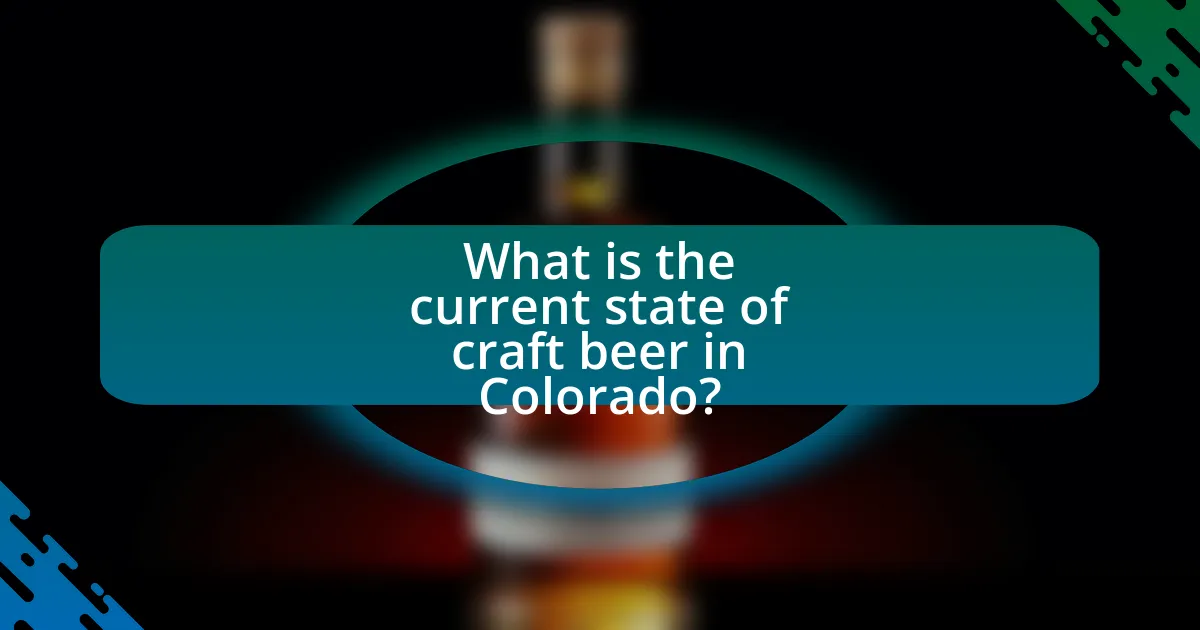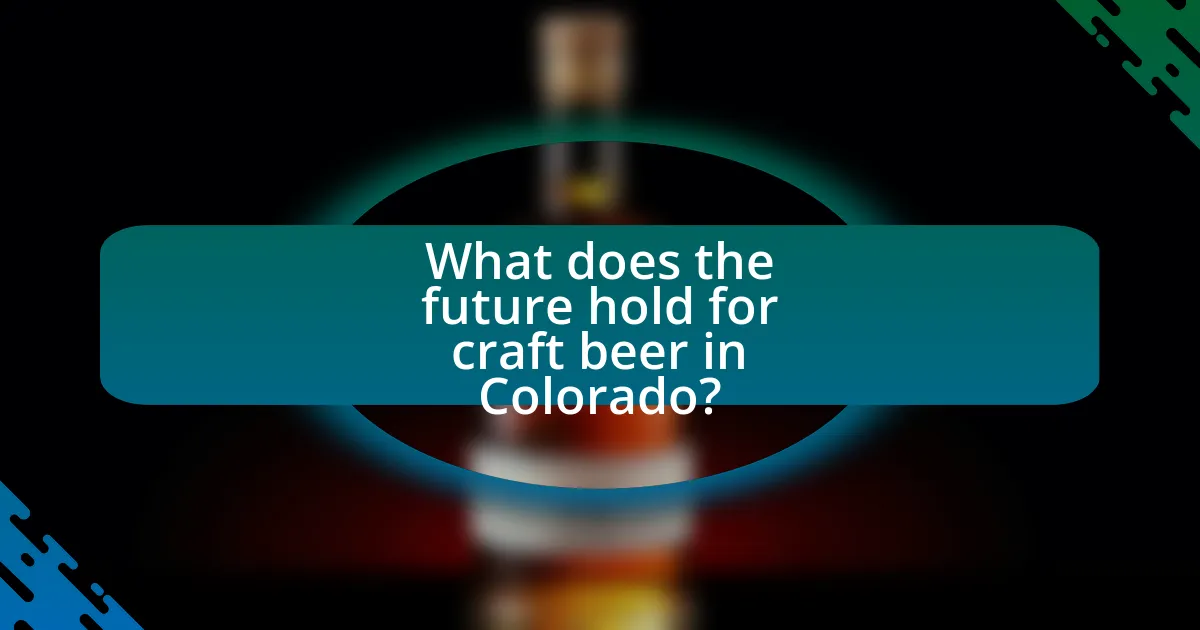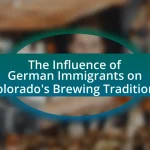The article examines the current state and future prospects of the craft beer industry in Colorado, highlighting its growth to over 400 breweries by 2023. It discusses the evolution of the industry since the 1980s, shaped by legislative changes, consumer preferences, and community engagement. Key challenges such as competition, rising costs, and regulatory hurdles are addressed, alongside effective strategies for breweries, including innovation and sustainability practices. The article also emphasizes the importance of local collaborations and community support in fostering a vibrant craft beer culture, while exploring emerging trends and technological advancements that will influence the industry’s future.

What is the current state of craft beer in Colorado?
The current state of craft beer in Colorado is robust and thriving, with over 400 breweries operating in the state as of 2023. Colorado ranks among the top states in the U.S. for craft beer production, contributing significantly to the local economy and culture. The state’s craft beer industry has seen a steady growth rate of approximately 5% annually, reflecting a strong consumer demand for diverse and innovative beer styles. Additionally, Colorado’s craft breweries have garnered numerous awards at national competitions, showcasing the high quality and creativity of their products. This vibrant landscape is supported by a community of passionate brewers and a loyal customer base, ensuring the continued success of craft beer in Colorado.
How has the craft beer industry evolved in Colorado over the years?
The craft beer industry in Colorado has evolved significantly since the 1980s, transitioning from a handful of breweries to over 400 by 2023. This growth has been driven by a combination of consumer demand for diverse beer styles, innovative brewing techniques, and supportive legislation, such as the 2012 law allowing breweries to sell directly to consumers. Additionally, Colorado’s craft beer scene has gained national recognition, with the state hosting the Great American Beer Festival, which showcases local breweries and attracts thousands of visitors annually. This evolution reflects a broader trend in the U.S. craft beer movement, where Colorado has emerged as a leader in quality and variety.
What historical events have shaped the craft beer landscape in Colorado?
The craft beer landscape in Colorado has been significantly shaped by the legalization of brewpubs in 1988, which allowed for the growth of small breweries. This legislative change led to a surge in craft breweries, with the number increasing from just a handful in the late 1980s to over 400 by 2023. Additionally, the 1996 introduction of the Colorado Craft Beer Week helped to promote local breweries and foster community engagement. The establishment of the Brewers Association in 2005 further solidified Colorado’s reputation as a craft beer hub, providing resources and support for local brewers. These events collectively contributed to Colorado becoming one of the leading states in craft beer production and culture.
How have consumer preferences influenced craft beer production in Colorado?
Consumer preferences have significantly influenced craft beer production in Colorado by driving breweries to diversify their offerings and focus on quality and local ingredients. As consumers increasingly seek unique flavors and experiences, Colorado breweries have responded by experimenting with various styles, such as IPAs, sours, and barrel-aged beers, to cater to these tastes. According to the Colorado Brewers Guild, the state has seen a rise in the number of craft breweries, which reached over 400 in 2023, reflecting the demand for innovative and locally sourced products. This shift in consumer behavior has also led to a greater emphasis on sustainability and community engagement, as breweries adopt practices that resonate with environmentally conscious consumers.
What challenges does the craft beer industry face in Colorado today?
The craft beer industry in Colorado faces several challenges today, including increased competition, rising operational costs, and regulatory hurdles. Increased competition arises from a growing number of breweries, with over 400 craft breweries operating in the state as of 2023, making it difficult for individual breweries to stand out. Rising operational costs, particularly for ingredients and labor, have been exacerbated by inflation, impacting profit margins. Additionally, regulatory hurdles, such as complex licensing requirements and changes in state laws, create barriers for new entrants and existing businesses trying to expand. These factors collectively threaten the sustainability and growth of the craft beer sector in Colorado.
How do regulatory changes impact craft breweries in Colorado?
Regulatory changes significantly impact craft breweries in Colorado by altering operational costs, distribution methods, and market access. For instance, the introduction of new licensing requirements can increase compliance costs, while changes in tax regulations can affect pricing strategies. Additionally, modifications to distribution laws, such as allowing self-distribution or expanding retail sales hours, can enhance market reach for breweries. According to the Colorado Brewers Guild, regulatory adjustments have historically influenced the growth trajectory of the craft beer sector, with favorable regulations contributing to a 20% increase in the number of craft breweries from 2019 to 2021.
What economic factors affect the growth of craft beer in Colorado?
The growth of craft beer in Colorado is primarily influenced by factors such as consumer spending power, local economic conditions, and regulatory environment. Consumer spending power in Colorado has increased, with disposable income rising, allowing residents to allocate more funds toward craft beer purchases. Additionally, the local economy, characterized by a strong tourism sector and a growing population, supports craft breweries by providing a steady customer base. Furthermore, favorable regulations, including lower taxes on craft breweries and supportive legislation, have created an environment conducive to the establishment and expansion of craft beer businesses. These economic factors collectively contribute to the robust growth of the craft beer industry in Colorado.

What lessons can be learned from the history of craft beer in Colorado?
The history of craft beer in Colorado teaches the importance of innovation, community engagement, and adaptability. Colorado’s craft beer scene began in the late 1970s and has grown significantly, with over 400 breweries as of 2023, demonstrating that a strong local culture and support can foster industry growth. The state’s breweries often emphasize unique flavors and local ingredients, showcasing the value of creativity in product development. Additionally, collaboration among breweries has been a hallmark of the Colorado craft beer community, illustrating that partnerships can enhance visibility and market reach. Finally, the ability to adapt to changing consumer preferences, such as the rise of low-alcohol and gluten-free options, highlights the necessity for breweries to remain flexible and responsive to market trends.
How have past successes influenced current craft beer trends?
Past successes in the craft beer industry have significantly shaped current trends by establishing a foundation of innovation and consumer preference. The rise of microbreweries in the 1980s and 1990s, exemplified by the success of breweries like Sierra Nevada and Boston Beer Company, demonstrated the viability of unique flavors and local sourcing, which encouraged new entrants to experiment with diverse styles and ingredients. This historical context has led to a contemporary emphasis on small-batch production, artisanal methods, and community engagement, as seen in the increasing popularity of IPAs and sour beers. Furthermore, the success of craft beer festivals and local taprooms has fostered a culture of collaboration and creativity, influencing current breweries to adopt similar business models that prioritize local connections and innovative brewing techniques.
What strategies have proven effective for Colorado craft breweries?
Effective strategies for Colorado craft breweries include community engagement, innovative marketing, and diversification of product offerings. Community engagement fosters local loyalty and support, as seen in breweries that host events and collaborate with local businesses. Innovative marketing, such as leveraging social media and unique branding, helps breweries stand out in a competitive market. Diversification of product offerings, including seasonal and specialty brews, attracts a wider customer base and encourages repeat visits. These strategies have been validated by the growth of the craft beer industry in Colorado, which has seen a significant increase in the number of breweries and overall sales, indicating successful implementation of these approaches.
How have failures in the industry provided valuable insights?
Failures in the craft beer industry have provided valuable insights by highlighting the importance of market research, quality control, and consumer preferences. For instance, the collapse of several breweries in Colorado during the early 2000s due to poor business planning and lack of differentiation taught current brewers the necessity of understanding their target audience and creating unique offerings. Additionally, the rise and fall of these businesses emphasized the critical role of maintaining high-quality standards, as evidenced by the fact that breweries with consistent quality have a higher survival rate. These lessons have shaped the strategies of successful craft breweries today, enabling them to adapt and thrive in a competitive market.
What role does community play in the success of craft breweries?
Community plays a crucial role in the success of craft breweries by fostering local support, loyalty, and engagement. Craft breweries often rely on their surrounding communities for patronage, which can significantly influence their sales and brand reputation. For instance, a study by the Brewers Association found that 85% of craft beer drinkers prefer to buy locally produced beer, highlighting the importance of community ties. Additionally, community events and collaborations with local businesses enhance visibility and create a sense of belonging, further solidifying the brewery’s place within the local culture. This interconnectedness not only drives customer loyalty but also encourages word-of-mouth marketing, which is vital for the growth of craft breweries.
How have local collaborations shaped the craft beer scene in Colorado?
Local collaborations have significantly shaped the craft beer scene in Colorado by fostering innovation and community engagement among breweries. These partnerships often lead to the creation of unique beer styles and flavors, as seen in collaborative brews like the “Collaboration Fest,” which showcases beers made by multiple breweries working together. Additionally, local collaborations enhance the sense of community, as breweries share resources, knowledge, and marketing efforts, contributing to a robust craft beer culture. For instance, the Colorado Brewers Guild actively promotes collaboration among its members, resulting in a diverse and vibrant craft beer landscape that attracts both locals and tourists.
What impact do craft beer festivals have on local breweries?
Craft beer festivals significantly boost local breweries by increasing their visibility and sales. These events provide a platform for breweries to showcase their products to a larger audience, often resulting in immediate sales and long-term customer loyalty. For instance, a study by the Brewers Association found that breweries participating in festivals reported an average sales increase of 20% during the event. Additionally, festivals foster community engagement and collaboration among local breweries, enhancing their reputation and encouraging repeat business.

What does the future hold for craft beer in Colorado?
The future of craft beer in Colorado is expected to see continued growth and innovation, driven by consumer demand for unique flavors and local products. As of 2023, Colorado boasts over 400 craft breweries, making it one of the leading states in craft beer production. The state’s craft beer market is projected to expand further, with trends indicating an increase in the popularity of sour beers, barrel-aged varieties, and non-alcoholic options. Additionally, the state’s favorable brewing regulations and strong community support for local businesses contribute to a robust environment for craft breweries. Historical data shows that Colorado’s craft beer industry has consistently adapted to consumer preferences, suggesting that this trend will persist, ensuring a vibrant future for craft beer in the region.
How are emerging trends likely to shape the craft beer industry?
Emerging trends are likely to shape the craft beer industry by driving innovation in flavors, sustainability practices, and consumer engagement. The rise of unique flavor profiles, such as fruit-infused and barrel-aged beers, reflects consumer demand for diverse and adventurous options, with 60% of craft beer drinkers expressing interest in trying new styles according to the Brewers Association. Additionally, sustainability trends are influencing breweries to adopt eco-friendly practices, such as using renewable energy and reducing water usage, which can enhance brand loyalty among environmentally conscious consumers. Furthermore, the increasing use of technology for direct-to-consumer sales and personalized marketing is reshaping how breweries connect with their customers, making it essential for craft breweries to adapt to these changes to remain competitive in the evolving market.
What innovations are being introduced in brewing techniques?
Innovations in brewing techniques include the use of advanced fermentation technology, such as temperature-controlled fermentation and the application of artificial intelligence for recipe optimization. These methods enhance flavor profiles and improve consistency in beer production. For instance, temperature-controlled fermentation allows brewers to fine-tune the fermentation process, resulting in better flavor development and reduced off-flavors. Additionally, AI-driven analytics can analyze vast amounts of brewing data to suggest ingredient combinations and brewing processes that yield superior results, as evidenced by breweries adopting these technologies to increase efficiency and product quality.
How is sustainability influencing the future of craft beer production?
Sustainability is significantly influencing the future of craft beer production by driving breweries to adopt eco-friendly practices that reduce waste and conserve resources. Many craft breweries are implementing sustainable methods such as using renewable energy sources, recycling water, and sourcing local ingredients to minimize their carbon footprint. For instance, a report from the Brewers Association indicates that 60% of craft breweries have adopted some form of sustainability initiative, showcasing a growing trend towards environmentally responsible production. This shift not only appeals to environmentally conscious consumers but also enhances operational efficiency and reduces costs in the long term.
What strategies can breweries adopt to thrive in a competitive market?
Breweries can thrive in a competitive market by focusing on product differentiation, community engagement, and innovative marketing strategies. Product differentiation allows breweries to create unique flavors and styles that cater to niche markets, which can attract a loyal customer base. For instance, breweries that offer seasonal or limited-edition brews often see increased sales during specific times of the year, as consumers seek novelty.
Community engagement is crucial; breweries that actively participate in local events and collaborate with other businesses can enhance their visibility and strengthen customer loyalty. Research shows that breweries involved in community initiatives experience a 20% increase in customer retention rates.
Innovative marketing strategies, such as leveraging social media platforms and influencer partnerships, can significantly expand a brewery’s reach. Data indicates that breweries utilizing targeted social media campaigns see a 30% increase in brand awareness. By implementing these strategies, breweries can effectively navigate the competitive landscape and secure their market position.
How can craft breweries leverage technology for growth?
Craft breweries can leverage technology for growth by implementing advanced brewing systems, utilizing data analytics for consumer insights, and enhancing marketing through digital platforms. Advanced brewing systems, such as automated brewing equipment, improve efficiency and consistency, allowing breweries to scale production while maintaining quality. Data analytics tools enable breweries to analyze customer preferences and market trends, leading to informed decision-making and targeted product development. Additionally, digital marketing strategies, including social media engagement and e-commerce platforms, expand reach and enhance customer interaction, driving sales growth. According to the Brewers Association, the craft beer market in the U.S. grew by 5% in 2022, highlighting the importance of technology in adapting to consumer demands and competitive landscapes.
What marketing approaches are most effective for attracting new customers?
Digital marketing strategies, particularly social media advertising and content marketing, are the most effective approaches for attracting new customers. Social media platforms like Instagram and Facebook allow craft beer brands to showcase their products visually, engage with potential customers, and build community through targeted ads. According to a 2021 survey by the Brewers Association, 60% of craft beer consumers discover new brands through social media, highlighting its significance. Additionally, content marketing, such as blogs and videos that educate consumers about brewing processes and beer styles, fosters brand loyalty and attracts new customers by providing valuable information. This dual approach of leveraging social media and content marketing has proven successful in the competitive craft beer market in Colorado.
What practical tips can craft breweries implement for future success?
Craft breweries can implement several practical tips for future success, including focusing on quality, building strong community ties, and leveraging digital marketing. Prioritizing quality ensures that the product meets consumer expectations, as evidenced by the Brewers Association’s report indicating that 70% of craft beer consumers prioritize taste. Establishing community connections fosters loyalty and repeat business, with studies showing that local engagement can increase sales by up to 20%. Additionally, utilizing digital marketing strategies, such as social media and targeted online advertising, can enhance visibility and attract new customers, as 54% of consumers report discovering new brands through social media platforms.


